
Vines with no thinning of crop (100 percent cropping)
Grape Root Growth and Physiology in Relation to Environment and Vine Crop Load
Lakso, Eissenstat, Xu, Dunst
May 15, 2003- May 14, 2007
USDA Special Funding: Cornell University-Viticulture Consortium Research Grants Program and New York Wine/Grape Foundation
The long-term goals of the work are to: (a) improve ourunderstanding of the regulation of grape root growth and respiration in relation to the environment (soil temperature, water, nutrients), and to varying crop load, and (b) integrate these root factors into a model of carbohydrate supply/demand. Ultimately, we want to optimize the management of both the top and the roots of the grapevine for sustained production of desired yields and fruit quality.
Objectives for 2006 Growing Season:
Our previous root growth studies have shown that at least 3 years of seasonal root growth monitoring to make any solid conclusions about field studies. Also, we have completed the controlled environment potted-vine studies on the effects of temperature and soil moisture outlined in the current and previous reports and publications, but these results need to validated under field conditions. Therefore the 2006 objectives are to:
- Monitor seasonal fine root production and survival in a mature vineyard crop load trial of constant pruning level for the 3rd year to determine the sustained effects
of adjusted crop loads on the production and lifespans of Concord grape fine roots. - In the same study determine the effects of crop load (and soil drying if the season is dry enough) on root respiration, membrane leakage, carbohydrate/nitrogen concentrations of grape roots.
- Take soil cores under mature Concord grapevines in the crop load study pre-veraison to estimate the total maximum amounts of fine roots per vine to allow the calculation of the total carbohydrate requirements of the root system.
- Determine normal daily patterns of root respiration and responses to canopy shading (to reduce carbohydrate supply to the roots) in mature field Concord vines.

